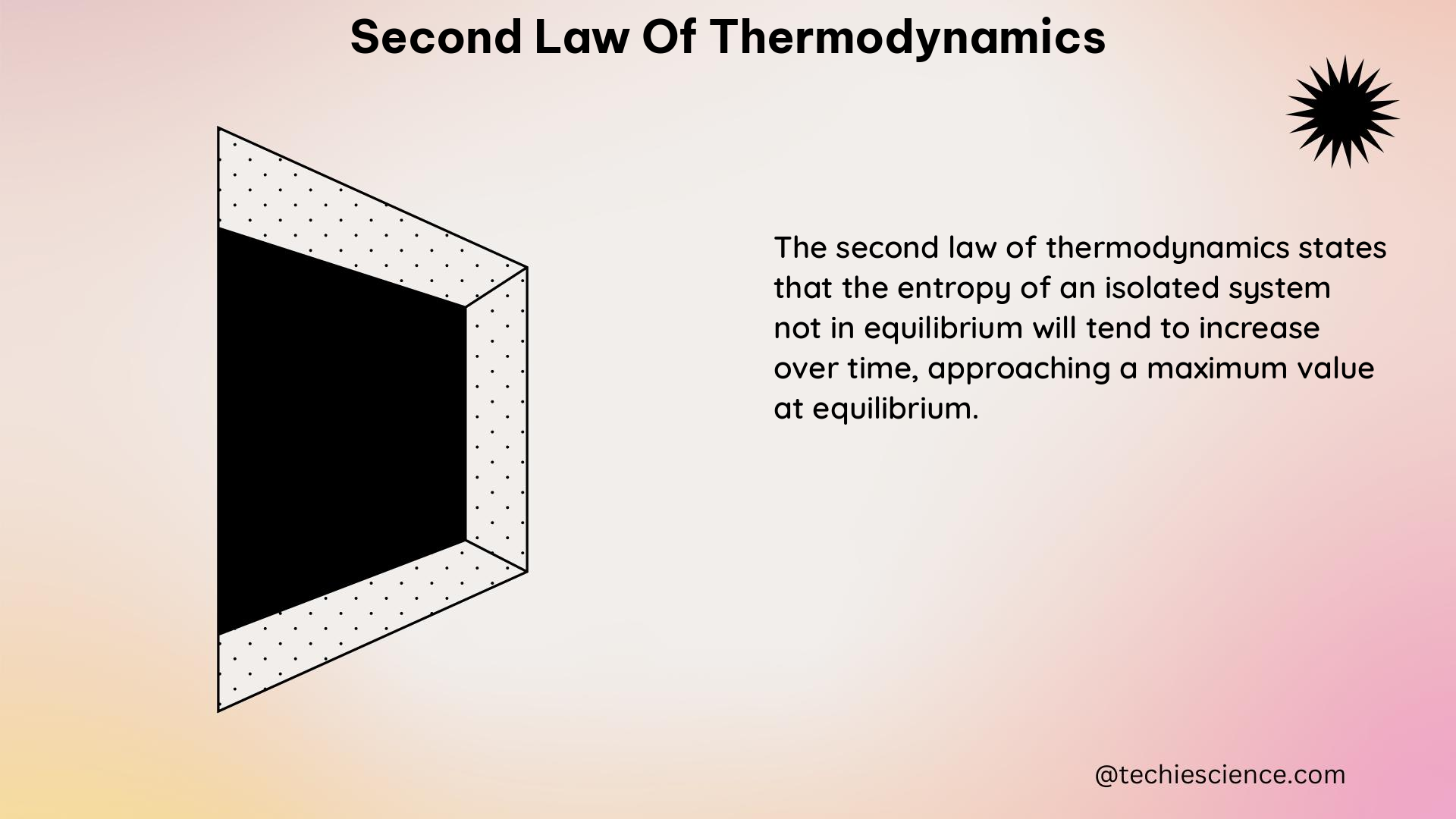The second law of thermodynamics is a fundamental principle that governs the behavior of all physical systems in the universe. It states that the total entropy of an isolated system can never decrease over time, and is constant if and only if all processes within the system are reversible. Entropy is a measure of the number of specific ways in which a system may be arranged, often interpreted as a measure of disorder or a measure of progressing towards thermodynamic equilibrium.
Understanding Entropy and Heat Flow
On a macroscopic scale, entropy is quantified by measuring heat flow. The change in entropy is defined as the “reversible” heat divided by the absolute temperature. The units of entropy are typically measured in joules per kelvin (J/K).
The second law can be expressed mathematically as:
ΔS ≥ Q/T
Where:
– ΔS is the change in entropy of the system
– Q is the heat transferred to the system
– T is the absolute temperature of the system
This equation tells us that the entropy of an isolated system can never decrease, and that the equality holds only for reversible processes.
The Efficiency of Heat Engines

The second law can also be stated in terms of the efficiency of heat engines. The efficiency of a heat engine is defined as the work done by the engine divided by the heat input to the engine. The second law states that no heat engine can have an efficiency greater than the Carnot efficiency, which is given by:
η = 1 - (TL/TH)
Where:
– η is the Carnot efficiency
– TL is the temperature of the low-temperature reservoir
– TH is the temperature of the high-temperature reservoir
This means that the maximum possible efficiency of a heat engine is limited by the temperatures of the reservoirs it operates between.
Statistical Mechanics and the Second Law
The traditional thermodynamic hypothesis does not account for the statistical variations in thermodynamic quantities. However, statistical mechanics, a branch of physics, can be used to explain the second law in terms of the behavior of particles and atoms.
Statistical mechanics hypothesizes that, in equilibrium, each microstate that the system may be in is equally likely to occur. When this assumption is made, it leads directly to the conclusion that the second law should hold from a statistical perspective.
The key idea is that there are many more ways for a system to be in a high-entropy state than a low-entropy state. As a result, high-entropy states are much more likely to occur, and the system will naturally tend to evolve towards a state of higher entropy.
Quantum Mechanics and the Second Law
In the context of quantum mechanics, there are many second laws of thermodynamics that apply on very small scales. These laws govern the behavior of systems made out of very few particles, and can lead to unexpected and counterintuitive phenomena.
For example, on the quantum scale, the second law can be violated in certain situations, such as in the case of Maxwell’s demon, a thought experiment that demonstrates how a demon could potentially decrease the entropy of a system by selectively allowing particles to pass through a barrier.
However, these quantum-scale violations of the second law are typically very small and short-lived, and the overall trend towards increasing entropy still holds true on the macroscopic scale.
Applications of the Second Law
The second law of thermodynamics has numerous applications in various fields of science and engineering, including:
-
Heat Engines and Refrigeration: The second law is crucial in the design and analysis of heat engines, such as internal combustion engines and steam turbines, as well as refrigeration systems, such as air conditioners and refrigerators.
-
Chemical Reactions and Equilibrium: The second law can be used to predict the direction and extent of chemical reactions, as well as the equilibrium state of a chemical system.
-
Biological Systems: The second law plays a fundamental role in understanding the behavior of living organisms, including the processes of metabolism, growth, and evolution.
-
Information Theory: The second law has important implications for the storage and transmission of information, as it sets limits on the efficiency of data processing and communication systems.
-
Cosmology and Astrophysics: The second law is essential in understanding the evolution of the universe, including the formation of stars, galaxies, and black holes, as well as the eventual heat death of the universe.
Conclusion
The second law of thermodynamics is a powerful and far-reaching principle that governs the behavior of all physical systems in the universe. By understanding the concepts of entropy and heat flow, as well as the statistical and quantum-mechanical aspects of the second law, we can gain deep insights into the fundamental workings of the natural world.
References
- Cengel, Y. A., & Boles, M. A. (2015). Thermodynamics: An Engineering Approach (8th ed.). McGraw-Hill Education.
- Atkins, P., & de Paula, J. (2014). Atkins’ Physical Chemistry (10th ed.). Oxford University Press.
- Kondepudi, D., & Prigogine, I. (1998). Modern Thermodynamics: From Heat Engines to Dissipative Structures. John Wiley & Sons.
- Feynman, R. P., Leighton, R. B., & Sands, M. (2015). The Feynman Lectures on Physics, Vol. 1: Mainly Mechanics, Radiation, and Heat. Basic Books.
- Penrose, R. (2010). Cycles of Time: An Extraordinary New View of the Universe. Alfred A. Knopf.

The lambdageeks.com Core SME Team is a group of experienced subject matter experts from diverse scientific and technical fields including Physics, Chemistry, Technology,Electronics & Electrical Engineering, Automotive, Mechanical Engineering. Our team collaborates to create high-quality, well-researched articles on a wide range of science and technology topics for the lambdageeks.com website.
All Our Senior SME are having more than 7 Years of experience in the respective fields . They are either Working Industry Professionals or assocaited With different Universities. Refer Our Authors Page to get to know About our Core SMEs.